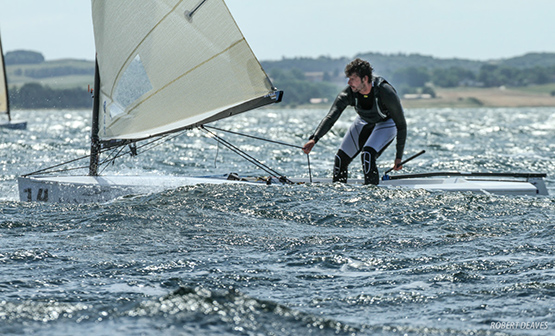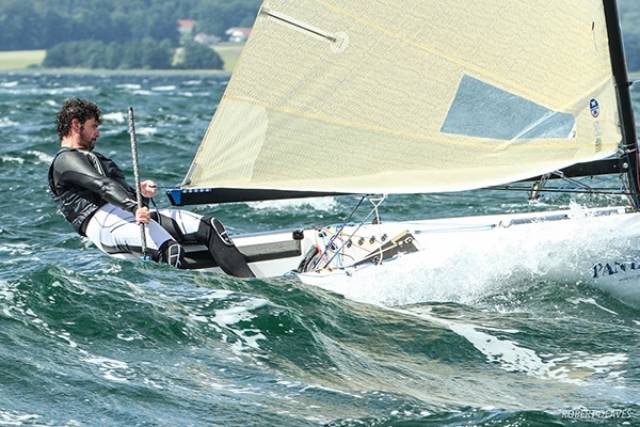If Finn sailors are looked upon as the giants of the sailing world, then Oisin Mcclelland (IRL) is a giant among Finn sailors writes Robert Deaves. At his second and final Finn Silver Cup this week in Aarhus he is using the event as a marker to assess his progress since he first stepped into the Finn just over a year ago. His plan is then to step up his campaign to qualify Ireland for the Tokyo 2020 Olympics and return to Aarhus in two years time for the first Olympic qualification event.
Oisin Mcclelland was always going to be a big man. “I started in the Laser at 16 and was quickly into the standard rig and soon ended up too big for a large part of my standard sailing. I jumped into the Finn last year – the 2015 Silver Cup was my first event. It was a baptism of fire but since then I have spent the last eight months training full time in the Finn at the Dinghy Academy in Valencia.”
He says the Finn was a natural fit to his physical size and intense physicality. “It always looked to me to be the boat I’d fit into because at my height I wouldn’t be the right weight for the Laser, and also the physicality of the boat was always an attraction. The guys at the top are some of the fittest athletes about and that’s really good motivation for those of us coming through. It’s cool to watch them and race against them.”
 Oisin Mcclelland Finn – 'Every time I get in the Finn it’s a pleasure to sail' Photo: Robert Deaves
Oisin Mcclelland Finn – 'Every time I get in the Finn it’s a pleasure to sail' Photo: Robert Deaves
This year he sailed his first major Finn events, the Europeans in Barcelona, the Princesa Sofia in Palma and the World Championships in Gaeta. “It’s been a huge learning curve but I feel like I have made progress and it was absolutely the right decision.”
Now he is making plans and looking further into the future. “Obviously the goal is to get to Tokyo representing Ireland. It’s great to be in Aarhus this week because it’s going to be the first real test to see if we can get a spot for the Games. The big goal at the moment to be in the best shape for that, and hopefully qualify yourself first time. So the next four years are going to be the most important time in the sport for many of us here.”
Oisin McClelland vital statistics:
Age – 22 • Weight – 100 kg • Height - 198cm
He feels like he is making good progress towards that goal. “At the moment after 12 months in the boat I feel like a lot of things are coming together and I am looking for a couple of good results in the coming season.”
“I have had a lot of support from the RYA NI and the Irish association. And they have been guiding me for the last 6-8 months. I also received a bit of help from the Mary Peters Trust in Northern Ireland. They are a charity that helps local athletes and sportsmen, and they have been a really big help and through their Make it Happen fund I got some money and it got me through to the end of the season this year and enabled me to get to the big events.”
Mcclelland is also part of the FINNTEAM, a funding programme of the International Finn Association to develop young sailors. “We’ll see where that ends up but it’s definitely good for promotion.”
“When I jumped into the Finn in Valencia you were surrounded by guys who had already qualified for the Games, so there was a real intensity going as they geared up for Rio and that gives you an insight into what you have to do get to Tokyo in four years time.”
“The guys there have been beyond helpful and that’s really accelerated the learning curve. I feel like I am making big jumps.”
He hopes to return to Aarhus several times before the 2018 Sailing World Championship. “The goal would be to get to Aarhus as much as possible as possible over the next two years. As we’ve seen here this week there is a lot to learn. It’s definitely going to be a challenge but it’s a great place to sail.”
Due to his size he’s always had an advantage in the breezy conditions. “It’s definitely one of my strengths, but I don’t like to see myself as a heavy weather sailor because then you end up just focussing on that. So currently one of my main focuses is the lighter winds, the right setup, the techniques I need. If I can hold on in the lighter stuff I know when the breeze comes in I stand a good chance of being around the front of the fleet.”
The main attraction for him is the daily challenge. “Every day I am in the boat it’s a challenge. Whether it’s light or windy, it’s either in your head or improving your physicality, and in the breezy stuff like yesterday, it’s a brilliant boat. Every time I get in the boat it’s a pleasure to sail. Also you’ll see in the results this week the calibre of the fleet – they are all mixing it with the top of the senior fleet as well so to come here for a junior event and have this high calibre in the fleet is incredible. You are not given an inch by anybody and having to fight for every position.”
“This time last year when I stepped into the Finn for the first time, Tokyo was there on the board as the dream goal and the plan was laid out. I think if I execute that plan properly, I‘ll see myself there in four years time.”





























































